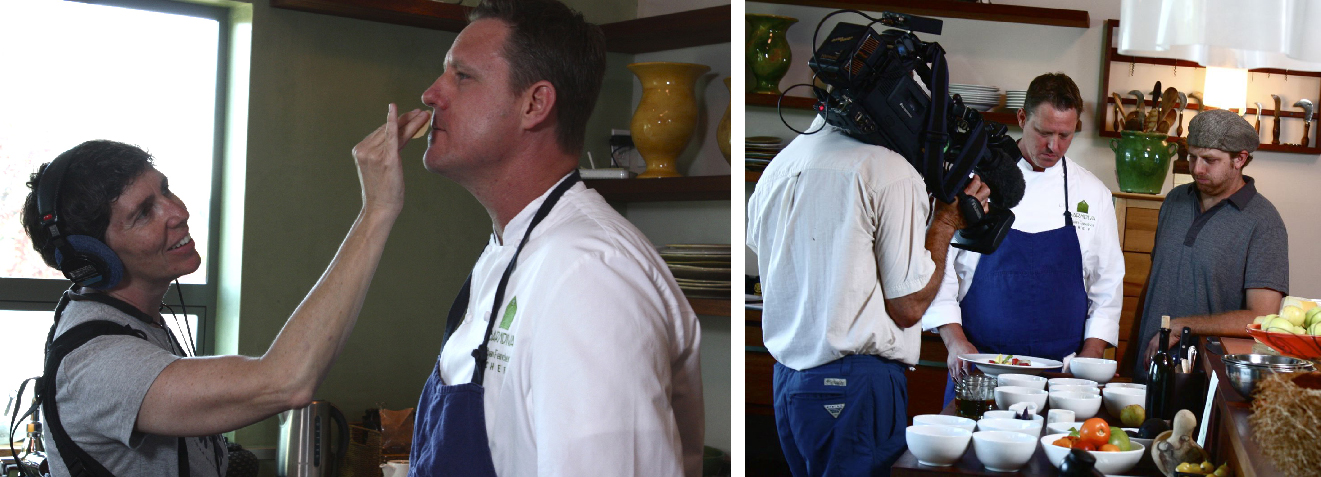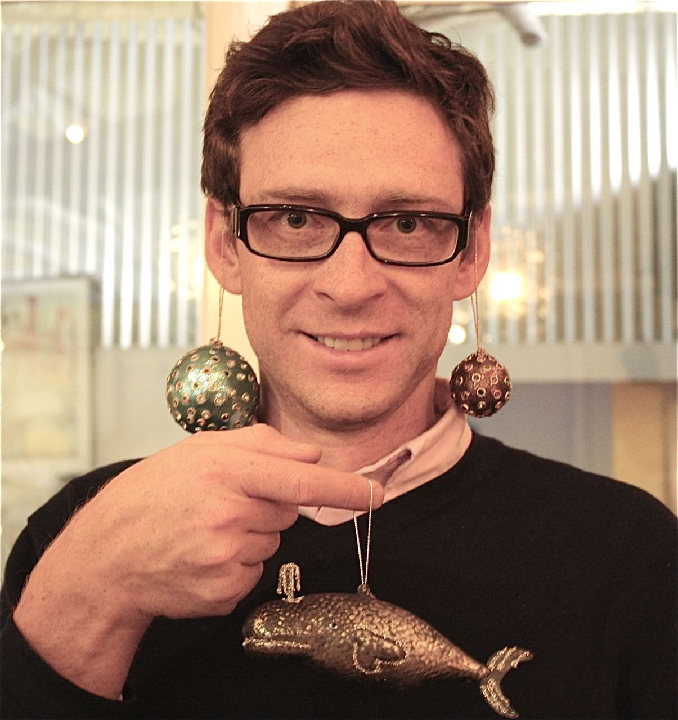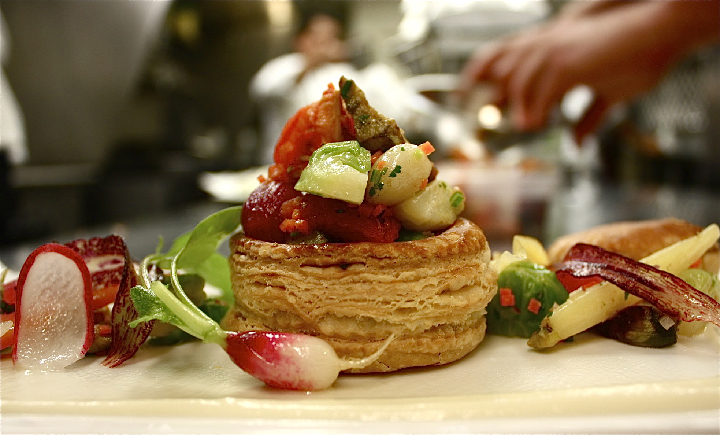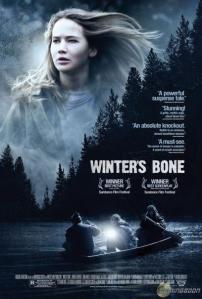Dish of the Week
Puff Pastry
 I don’t know if it's true or not that puff pastry was “invented” by one Claude Gellée, AKA Claude Lorrain, the man John Constable called “the most perfect landscape painter the world ever saw,” but it certainly makes for a damn good story. Food lore has it that Gellée stumbled upon the method one afternoon when trying to bake bread for his ailing father. Up against the clock, instead of waiting for his dough to rise he began to just fold and roll, fold and roll. The rest is history, the flakey kind in at least one sense of the word, as it eventually inspired thousands of savory and dessert classics. As Gellée’s father is known to have died when he was 12, one can only extrapolate that the 17th Century painter ~ born into poverty, soon to be an orphan in charge of his five brothers ~ was a savant baker long before he picked up a brush.
I don’t know if it's true or not that puff pastry was “invented” by one Claude Gellée, AKA Claude Lorrain, the man John Constable called “the most perfect landscape painter the world ever saw,” but it certainly makes for a damn good story. Food lore has it that Gellée stumbled upon the method one afternoon when trying to bake bread for his ailing father. Up against the clock, instead of waiting for his dough to rise he began to just fold and roll, fold and roll. The rest is history, the flakey kind in at least one sense of the word, as it eventually inspired thousands of savory and dessert classics. As Gellée’s father is known to have died when he was 12, one can only extrapolate that the 17th Century painter ~ born into poverty, soon to be an orphan in charge of his five brothers ~ was a savant baker long before he picked up a brush.
 Of course centuries before Gellée’s discovery, across the Mediterranean Basin bakers were making a flatter version of puff pastry we came to call Phyllo Dough. Two salient differences: the type of fat used, and, crucially, the number of layers in the final product. Where Phyllo traditionally uses oil, a classic French Puff Pastry usually relies upon butter…a not inconsequential amount of it. And while the perfect Baklava may look like it has tons of layers, it doesn't have anywhere near 730, the number needed, according to the mathematical equation offered by none other than Julia Child in Vol II of The Art of French Cooking, for a perfect pâte feuilletée fine.
Of course centuries before Gellée’s discovery, across the Mediterranean Basin bakers were making a flatter version of puff pastry we came to call Phyllo Dough. Two salient differences: the type of fat used, and, crucially, the number of layers in the final product. Where Phyllo traditionally uses oil, a classic French Puff Pastry usually relies upon butter…a not inconsequential amount of it. And while the perfect Baklava may look like it has tons of layers, it doesn't have anywhere near 730, the number needed, according to the mathematical equation offered by none other than Julia Child in Vol II of The Art of French Cooking, for a perfect pâte feuilletée fine.
 Still, the science is the same: unleavened pastry is repeatedly folded, rolled and chilled. When the pastry shell hits the heat of a hot oven, moisture in the dough forms steam causing the pastry to rise on the seam lines of the folds as the water evaporates. Shortening or lard can be used to make Puff Pastry ~ with a higher melting point than butter they allow the pastry to rise faster ~ but for that rich buttery mouth feel, Ryan believes you need…well….butter.
Still, the science is the same: unleavened pastry is repeatedly folded, rolled and chilled. When the pastry shell hits the heat of a hot oven, moisture in the dough forms steam causing the pastry to rise on the seam lines of the folds as the water evaporates. Shortening or lard can be used to make Puff Pastry ~ with a higher melting point than butter they allow the pastry to rise faster ~ but for that rich buttery mouth feel, Ryan believes you need…well….butter.
Vol-au-vent ~'windblown' ~ is the lovely French name for the pastry shell, which can be filled with just about anything. Our Vol-au-vent this week is a savory dish that is all about the taste and beauty of vegetables. To make the Puff Pastry shell Chef cuts chilled Puff Pastry into rounds with a fluted edge, brushing each stack with a little egg white as he works. Toy Box carrots and radishes are shaved and lightly dressed for a raw salad condiment while the rest of the ingredients ~ artichoke hearts, oven roasted tomatoes, brussels, pearl red and yellow onions, garlic confit, spinach, carrots, celery and fines herbs ~ are whittled or minced to within an inch of their life before being sautéed à la minute, while the shells are baking. Assembly takes place just before the dish leaves the kitchen.
 A word about the labor-intensive job of getting our vegetables into the shape and size you see here: it’s not folly. Just like a diamond needs to be precisely cut to show its facets to greatest sparkle when light hits it, the cut and size of vegetables has a great deal to do with how they taste, and even how they feel, in the mouth.
A word about the labor-intensive job of getting our vegetables into the shape and size you see here: it’s not folly. Just like a diamond needs to be precisely cut to show its facets to greatest sparkle when light hits it, the cut and size of vegetables has a great deal to do with how they taste, and even how they feel, in the mouth.
Served on Onion Soubise with a pillow of Puff Pastry on the side, this Vol-au-vent is an elegant dish which makes a beautiful entrée this time of year. Using the same vegetables you have on hand to accompany the bird, with a little extra effort you can serve your vegetarian guests something even the diehard carnivores ~ and the odd landscape painter ~ will look down the holiday table at with envy.
The Big Cheese
 Don't miss Barndiva and our wonderful friends at Bellwether Farms on the Cooking Channel this week. Filmed a few months ago for the exciting new series called The Big Cheese, (no, it doesn't refer to Ryan, but after we see the episode maybe it will), the program follows several types of cheese being made at Bellwether Farms which Chef then prepares and serves in Barndiva's upstairs studio. (Above: Chef Ryan getting ready for his close up, and with Big Cheese host Jason Sobocinski)
Don't miss Barndiva and our wonderful friends at Bellwether Farms on the Cooking Channel this week. Filmed a few months ago for the exciting new series called The Big Cheese, (no, it doesn't refer to Ryan, but after we see the episode maybe it will), the program follows several types of cheese being made at Bellwether Farms which Chef then prepares and serves in Barndiva's upstairs studio. (Above: Chef Ryan getting ready for his close up, and with Big Cheese host Jason Sobocinski)
Barndiva and Bellwether on The Big Cheese November 17 @ 9:30PM and 1:30AM (program your TIVO!) or November 19 at 6pm.
Holiday Parties
 The holidays are upon us, the first with Dawid at the helm of the Gallery. Though we've told him he absolutely cannot put any Christmas decorations out before the 'official' launch of the season, the day after Thanksgiving, we fear his naturally infectious enthusiasm ~ which he informs us only gets heightened at Christmas ~ may be getting the better of him.
The holidays are upon us, the first with Dawid at the helm of the Gallery. Though we've told him he absolutely cannot put any Christmas decorations out before the 'official' launch of the season, the day after Thanksgiving, we fear his naturally infectious enthusiasm ~ which he informs us only gets heightened at Christmas ~ may be getting the better of him.
Studio Barndiva, along with the entire town of Healdsburg, will celebrate the holidays together on Friday, November 25th, from 6-8.
Join us for Cocktails and Croque-en-bouche.
All text Jil Hales. All photos Jil Hales and Dawid Jaworski (unless otherwise noted).













